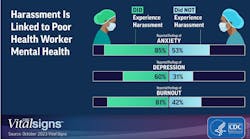Health workers report harassment, symptoms of poor mental health, and difficult working conditions
Oct. 25, 2023
3 min read
More than double the number of health workers reported harassment at work in 2022 than in 2018. This may include threats, bullying, verbal abuse, or other actions from patients and coworkers that create a hostile work environment. This finding has important implications for health worker mental health, according to a new CDC Vital Signs report.
Health worker burnout was at crisis levels prior to the COVID-19 pandemic. The new Vital Signs issue reports that the pandemic presented unique challenges that may have further impaired health worker mental health and increased health workers’ intent to leave their jobs.
- This report is one of the first to describe and compare self-reported well-being and working conditions for health workers, other essential workers, and all other workers before the pandemic (2018) and after the start of the pandemic (2022). It shows that health workers have continued to face a mental health crisis. From 2018 to 2022, U.S. health workers experienced greater declines on a range of mental health outcomes than other workers.
- Positive working conditions were found to be associated with reduced feelings of anxiety, depression, and burnout. These conditions may include the ability to participate in decision-making, trust in management, supervisor assistance, enough time to complete work, support for productivity, and lack of harassment.
A Call to Action:
- To promote worker well-being, employers can modify working conditions and change aspects of the organizational structure that are associated with poor mental health. This study suggests such changes could include allowing health workers to participate in decision-making, building trust in management, providing supervisor assistance and enough time to complete work, and preventing and paying attention to harassment reports.
- Employers can learn more about health workers and mental health through NIOSH’s Health Worker Mental Health Initiative, and about mental health in general. Visit the NIOSH Total Worker Health Program and the Healthy Work Design and Well-Being Program to learn more about how work conditions and work design impact worker well-being.
- Supervisors and workers can discuss ways to improve working conditions. For both supervisors and employees, NIOSH has training and resources for health workers on stress, fatigue, burnout, substance use, and suicide.
- The general public can support health workers by expressing appreciation for their essential work and treating them with understanding and respect.
About the Author
Sign up for our eNewsletters
Get the latest news and updates

